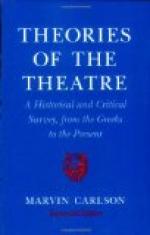Doubtless no one would dissent from Hamlet’s dictum that the purpose of playing is “to hold, as ’t were, the mirror up to nature”; but this statement is so exceedingly simple that it is rather difficult to understand. What special kind of mirror did that wise dramatic critic have in mind when he coined this memorable phrase? Surely he could not have intended the sort of flat and clear reflector by the aid of which we comb our hair; for a mirror such as this would represent life with such sedulous exactitude that we should gain no advantage from looking at the reflection rather than at the life itself which was reflected. If I wish to see the tobacco jar upon my writing table, I look at the tobacco jar: I do not set a mirror up behind it and look into the mirror. But suppose I had a magic mirror which would reflect that jar in such a way as to show me not only its outside but also the amount of tobacco shut within it. In this latter case, a glance at the represented image would spare me a more laborious examination of the actual object.
Now Hamlet must have had in mind some magic mirror such as this, which, by its manner of reflecting life, would render life more intelligible. Goethe once remarked that the sole excuse for the existence of works of art is that they are different from the works of nature. If the theatre showed us only what we see in life itself, there would be no sense at all in going to the theatre. Assuredly it must show us more than that; and it is an interesting paradox that in order to show us more it has to show us less. The magic mirror must refuse to reflect the irrelevant and non-essential, and must thereby concentrate attention on the pertinent and essential phases of nature. That mirror is the best that reflects the least which does not matter, and, as a consequence, reflects most clearly that which does. In actual life, truth is buried beneath a bewilderment of facts. Most of us seek it vainly, as we might seek a needle in a haystack. In this proverbial search we should derive no assistance from looking at a reflection of the haystack in an ordinary mirror. But imagine a glass so endowed with a selective magic that it would not reflect hay but would reflect steel. Then, assuredly, there would be a valid and practical reason for holding the mirror up to nature.
The only real triumph for an artist is not to show us a haystack, but to make us see the needle buried in it,—not to reflect the trappings and the suits of life, but to suggest a sense of that within which passeth show. To praise a play for its exactitude in representing facts would be a fallacy of criticism. The important question is not how nearly the play reflects the look of life, but how much it helps the audience to understand life’s meaning. The sceneless stage of the Elizabethan As You Like It revealed more meanings than our modern scenic forests empty of Rosalind and Orlando. There is no virtue in reflection unless there be some




